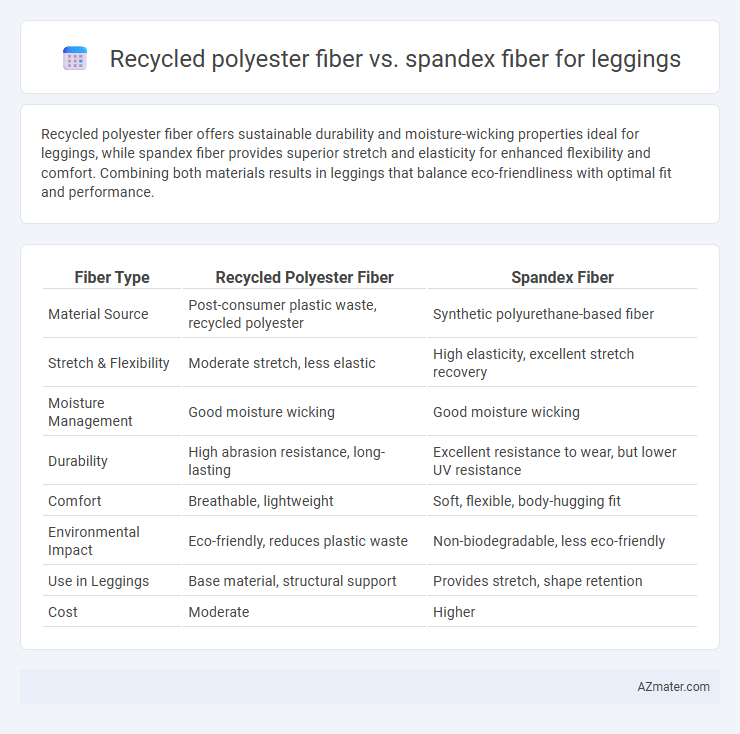Recycled polyester fiber offers sustainable durability and moisture-wicking properties ideal for leggings, while spandex fiber provides superior stretch and elasticity for enhanced flexibility and comfort. Combining both materials results in leggings that balance eco-friendliness with optimal fit and performance.
Table of Comparison
| Fiber Type | Recycled Polyester Fiber | Spandex Fiber |
|---|---|---|
| Material Source | Post-consumer plastic waste, recycled polyester | Synthetic polyurethane-based fiber |
| Stretch & Flexibility | Moderate stretch, less elastic | High elasticity, excellent stretch recovery |
| Moisture Management | Good moisture wicking | Good moisture wicking |
| Durability | High abrasion resistance, long-lasting | Excellent resistance to wear, but lower UV resistance |
| Comfort | Breathable, lightweight | Soft, flexible, body-hugging fit |
| Environmental Impact | Eco-friendly, reduces plastic waste | Non-biodegradable, less eco-friendly |
| Use in Leggings | Base material, structural support | Provides stretch, shape retention |
| Cost | Moderate | Higher |
Introduction to Legging Fabrics
Recycled polyester fiber offers sustainable benefits and moisture-wicking properties, making it a popular choice for eco-friendly leggings. Spandex fiber provides exceptional stretch and shape retention, ensuring a comfortable and flexible fit during physical activities. Combining recycled polyester with spandex enhances durability, elasticity, and environmental impact, optimizing overall legging fabric performance.
What is Recycled Polyester Fiber?
Recycled polyester fiber is produced from post-consumer plastic waste such as PET bottles, which are cleaned, melted, and spun into new textile fibers, offering a sustainable alternative to virgin polyester. This eco-friendly material provides excellent durability, moisture-wicking properties, and resistance to shrinking and wrinkles, making it ideal for activewear like leggings. In contrast, spandex fiber, known for its exceptional elasticity, is often blended with polyester to enhance stretch and comfort without compromising the environmental benefits of recycled polyester.
What is Spandex Fiber?
Spandex fiber, also known as elastane, is a synthetic fiber renowned for its exceptional elasticity, often used in leggings to provide superior stretch and shape retention. Recycled polyester fiber is an eco-friendly alternative made from repurposed plastic waste, offering durability and moisture-wicking properties but less elasticity compared to spandex. Combining recycled polyester with spandex enhances leggings by balancing sustainability with comfort and flexibility.
Key Differences Between Recycled Polyester and Spandex
Recycled polyester fiber, derived from post-consumer plastic waste, offers high durability, moisture-wicking properties, and environmental sustainability, making it ideal for eco-friendly leggings. Spandex fiber, known for its exceptional elasticity and stretch recovery, provides superior flexibility and shape retention, enhancing comfort and fit in activewear. Key differences include recycled polyester's emphasis on sustainability and moisture management versus spandex's focus on stretchability and flexibility in leggings performance.
Comfort and Fit in Leggings: Polyester vs Spandex
Recycled polyester fiber offers durability and moisture-wicking properties that enhance comfort by keeping skin dry during activity, making it suitable for everyday wear leggings. Spandex fiber provides superior stretch and elasticity, ensuring a snug fit that moves seamlessly with the body for optimal flexibility and shape retention in performance leggings. Combining recycled polyester with spandex often results in leggings that balance comfort, support, and fit, ideal for both casual and active use.
Durability and Performance Comparison
Recycled polyester fiber offers superior durability for leggings, maintaining shape and color after multiple washes due to its high resistance to abrasion and UV exposure. Spandex fiber excels in performance by providing exceptional stretch and recovery, enhancing flexibility and comfort during physical activities. Combining recycled polyester with spandex results in leggings that deliver both long-lasting wear and optimal flexibility for active use.
Sustainability and Environmental Impact
Recycled polyester fiber in leggings significantly reduces reliance on virgin petroleum resources and decreases landfill waste by repurposing plastic bottles, leading to lower carbon emissions and water usage compared to traditional polyester production. Spandex fiber, though offering superior stretch and comfort, is less sustainable due to its synthetic polyurethane base, which is non-biodegradable and requires toxic chemicals and high energy during manufacturing. Prioritizing recycled polyester in leggings enhances eco-friendly performance while minimizing environmental impact relative to spandex's resource-intensive production and disposal challenges.
Moisture-Wicking and Breathability Analysis
Recycled polyester fiber in leggings offers superior moisture-wicking properties by efficiently drawing sweat away from the skin, enhancing comfort during intense workouts. Spandex fiber, while providing excellent stretch and flexibility, generally exhibits lower breathability and moisture management compared to recycled polyester. Integrating recycled polyester boosts ventilation and dryness, making it a preferred choice for activewear focused on moisture control and breathability.
Price and Market Availability
Recycled polyester fiber offers a cost-effective alternative to spandex fiber for leggings, typically priced lower due to its sustainable production methods and widespread availability from multiple suppliers globally. Spandex fiber, prized for its superior elasticity and stretch, commands higher prices and is primarily sourced from specialized manufacturers, limiting its market availability compared to recycled polyester. The growing demand for eco-friendly apparel drives increased production scale of recycled polyester, enhancing market presence and accessibility relative to spandex fibers in the activewear sector.
Choosing the Best Fiber for Your Leggings
Recycled polyester fiber offers superior moisture-wicking and durability, making it an eco-friendly choice for leggings designed for high-performance activities. Spandex fiber excels in elasticity and shape retention, providing exceptional comfort and flexibility for form-fitting leggings. For leggings balancing sustainability and stretch, a blend of recycled polyester and spandex often delivers optimal performance and comfort.

Infographic: Recycled polyester fiber vs Spandex fiber for Legging
 azmater.com
azmater.com